Unveiling the Role of MSCs in Regenerative Medicine
Mesenchymal stem cells (MSCs) have emerged as a revolutionary force in regenerative medicine, offering promising therapeutic avenues for injury repair and inflammation control. These multipotent cells, found in various tissues, perform critical biological functions including tissue regeneration, immune modulation, and secretion of trophic factors that orchestrate healing. This article explores the cellular and molecular mechanisms MSCs use to support tissue healing, their interaction with immune responses, clinical applications, challenges, and future directions in treating injury and inflammatory diseases.
Understanding Mesenchymal Stem Cells and Their Biological Functions Relevant to Injury and Inflammation
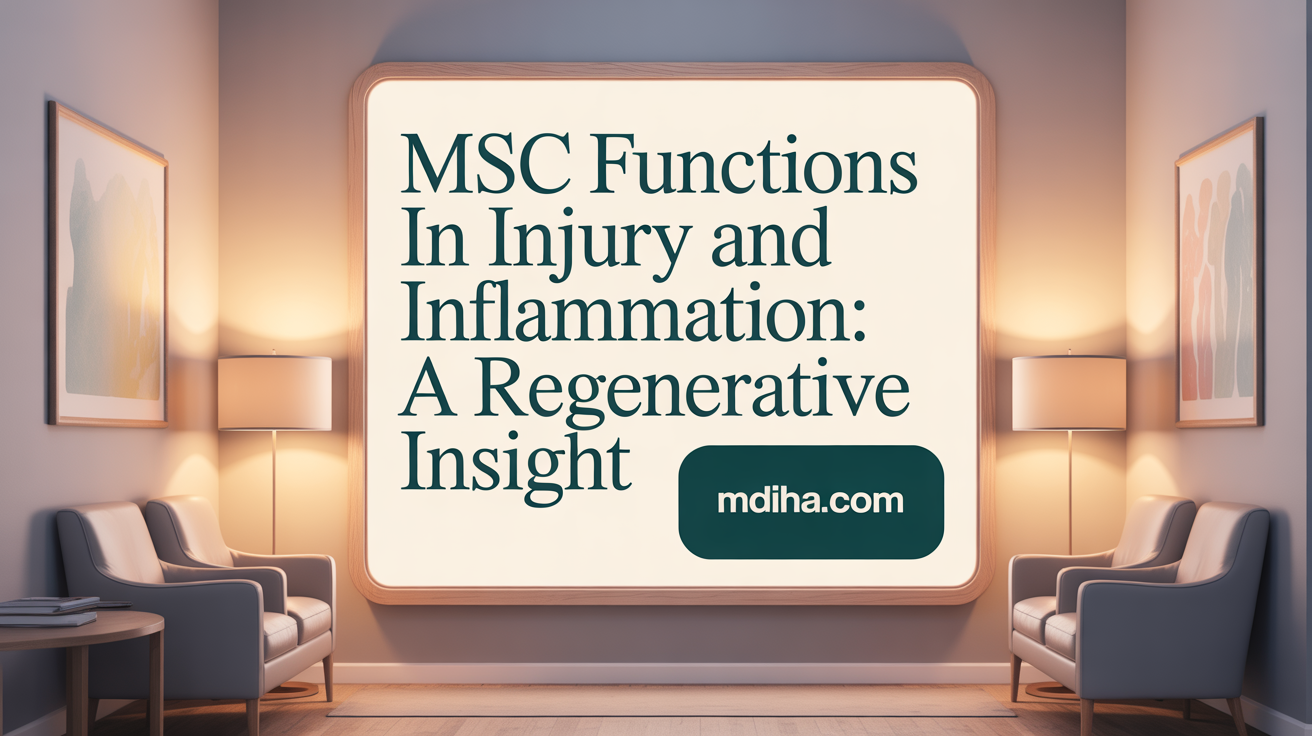
What are mesenchymal stem cells and their biological functions relevant to injury and inflammation?
Mesenchymal stem cells (MSCs) are multipotent stromal cells capable of differentiating into a variety of tissue types, including bone, cartilage, and fat. They are also able to generate neural, hepatic, and other cell lineages under certain conditions. These cells are found in diverse tissues such as bone marrow, adipose tissue, umbilical cord, and peripheral blood.
MSCs have a significant role in responding to injury and inflammation. They secrete a broad spectrum of trophic factors like vascular endothelial growth factor (VEGF), hepatocyte growth factor (HGF), and fibroblast growth factors (FGFs), which promote tissue survival, new blood vessel formation, and regeneration. Their secretory activity includes cytokines, chemokines, and extracellular vesicles such as exosomes, which carry proteins, microRNAs, and other molecules supporting tissue repair.
An essential feature of MSCs is their ability to regulate immune responses. They produce anti-inflammatory proteins like IL-10, TGF-β, and PGE2 and express membrane molecules such as HLA-G and PD-L1. These factors help suppress excessive immune reactions, modulate the activity of T cells, B cells, natural killer (NK) cells, and dendritic cells, and encourage an anti-inflammatory environment.
MSCs can locate to sites of injury or inflammation through chemotactic signals. Molecules such as CXCR4 enable MSCs to respond to chemokines like CXCL12, guiding them towards areas needing repair. This homing ability, combined with their responsive secretory profile, makes MSCs potent coordinators of tissue healing.
Overall, MSCs support tissue repair and maintain immune homeostasis mainly through their paracrine actions and immunomodulatory functions. Their capacity to home to damaged tissues, secrete healing-promoting factors, and modulate immune cells makes them promising agents in regenerative medicine for injury and inflammatory diseases.
Mechanisms of Tissue Healing and Regeneration Supported by Mesenchymal Stem Cells
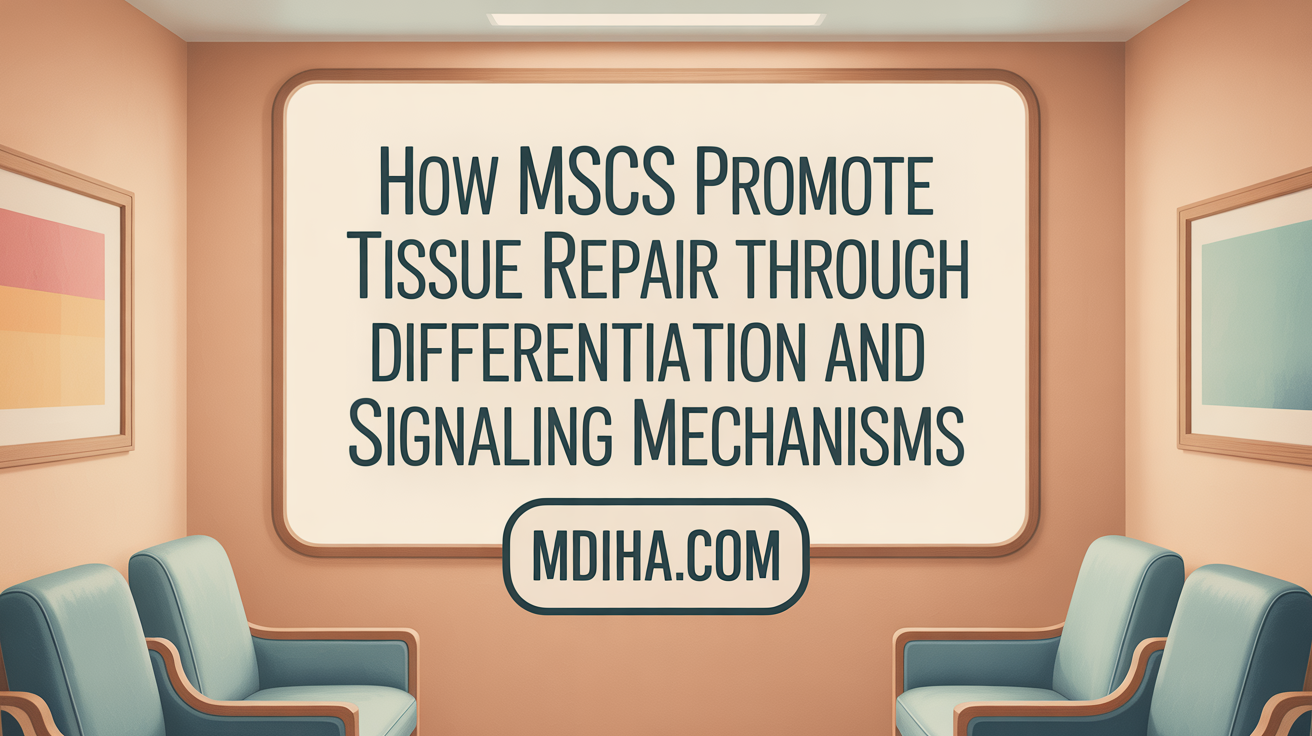
How do stem cells support tissue healing and regeneration after injury?
Stem cells play a central role in repairing damaged tissues by generating new, healthy cells that replace those that are injured or lost. They possess the unique ability to differentiate into specific cell types needed for repair, such as muscle cells, nerve cells, or blood cells, depending on the tissue they target.
Their capacity for self-renewal ensures a steady supply of cells, which is vital for ongoing tissue regeneration. Natural reservoirs of stem cells in various tissues become activated following injury, responding to local signals to facilitate healing.
In addition to their differentiation abilities, stem cells secrete trophic factors—proteins that promote cell survival, angiogenesis, and tissue remodeling. These paracrine effects enhance the repair process by reducing inflammation, supporting new blood vessel formation, and encouraging the proliferation of resident cells.
Modern stem cell therapies utilize these properties to improve recovery in tissues with limited regenerative capacity such as the heart, spinal cord, and joints. This multifaceted approach—combining direct cell replacement and supportive paracrine signaling—makes stem cells powerful agents in tissue healing and regeneration.
Cellular and Molecular Mechanisms of MSC Immunomodulation during Tissue Injury
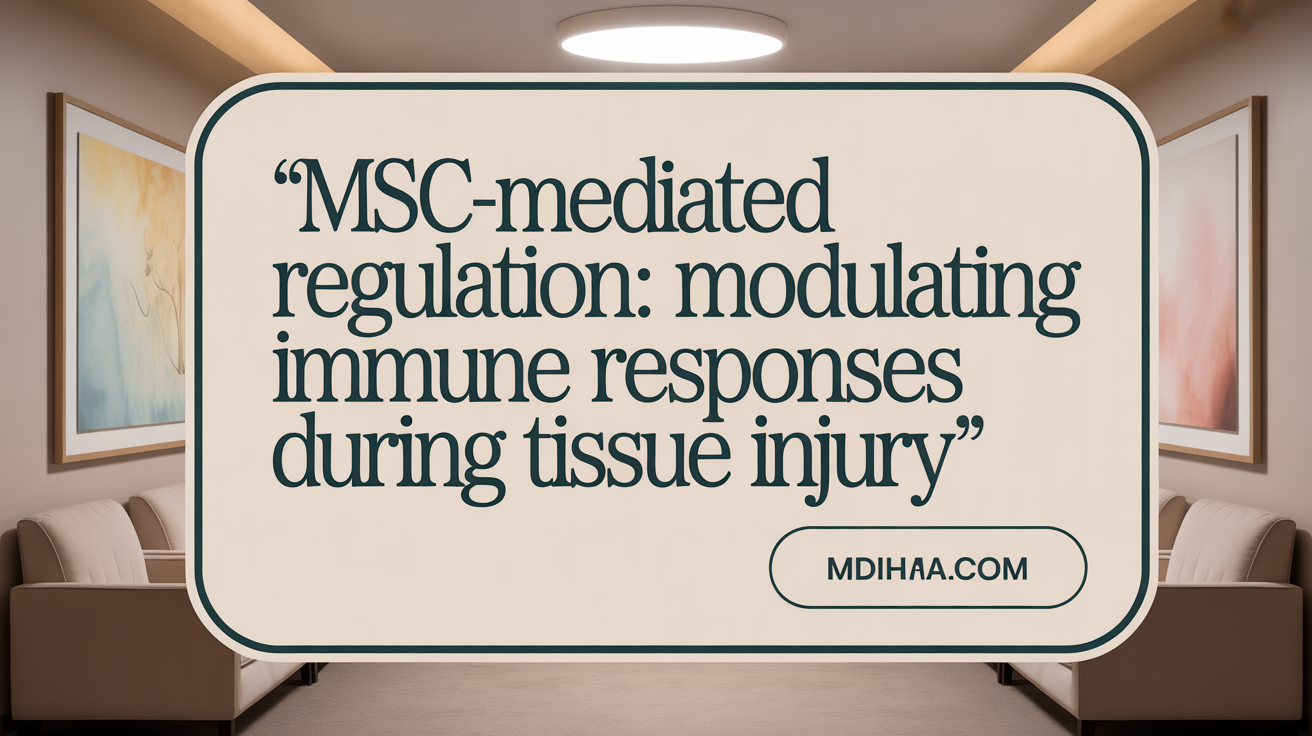
How do mesenchymal stem cells interact with immune responses during tissue injury?
Mesenchymal stem cells (MSCs) are central players in managing immune responses during tissue injury. When injury occurs, immune cells such as T cells, macrophages, NK cells, and dendritic cells release inflammatory cytokines like IL-1β, IFN-γ, and TNF-α. These cytokines serve as signals for MSCs, alerting them to the inflammatory environment.
Upon sensing these signals, MSCs respond by secreting a variety of immunosuppressive and regulatory factors. Notably, they produce indoleamine 2,3-dioxygenase (IDO), prostaglandin E2 (PGE2), and transforming growth factor-beta (TGF-β). These molecules work together to suppress overactive immune responses, reducing tissue damage caused by excessive inflammation.
Beyond secreting soluble factors, MSCs also influence the phenotype and activity of immune cells directly. They promote the development of regulatory T cells (Tregs), which help calm inflammation and facilitate tissue repair. MSCs can inhibit the proliferation and cytotoxic functions of T cells and NK cells, and modulate dendritic cell maturation towards a state that favors immune tolerance.
This bidirectional crosstalk between MSCs and immune cells creates a balanced environment that limits damaging inflammation while promoting healing. The overall effect is a controlled immune response that prevents chronic inflammation, supports tissue regeneration, and maintains immune homeostasis during tissue injury and repair processes.
How Mesenchymal Stem Cells Reduce Inflammation: Key Mechanisms at Play
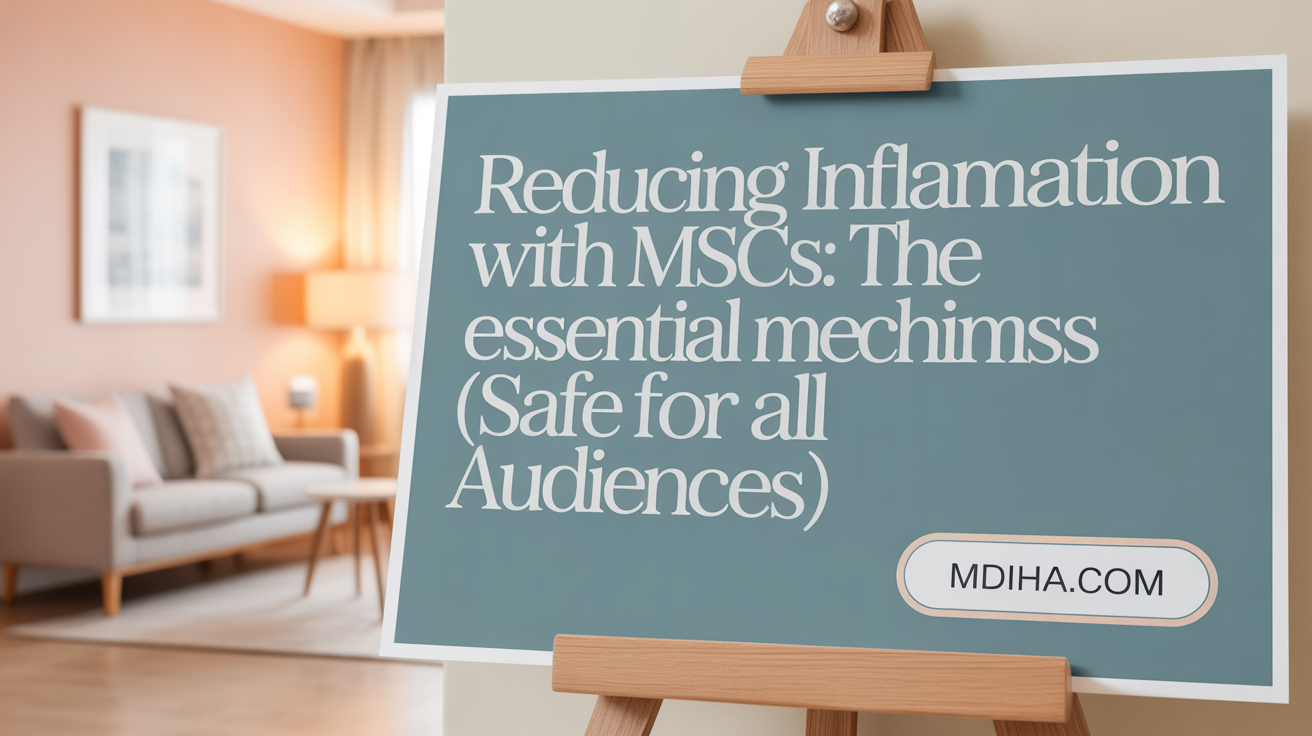
What mechanisms do mesenchymal stem cells use to reduce inflammation?
Mesenchymal stem cells (MSCs) are essential players in controlling inflammation and facilitating tissue healing. They detect signals of inflammation through pattern recognition receptors that sense damage-associated molecular patterns (DAMPs) and pathogen-associated molecular patterns (PAMPs). Once activated, MSCs respond by secreting a diverse array of bioactive molecules.
A crucial aspect of their anti-inflammatory action involves releasing cytokines like IL-10 and TGF-β, which suppress harmful immune responses and promote tolerance. These cytokines help shift the immune balance from a destructive inflammatory state to a healing environment.
MSCs also produce soluble factors such as prostaglandin E2 (PGE2), indoleamine 2,3-dioxygenase (IDO), and nitric oxide (NO). PGE2 can reprogram immune cells like macrophages and dendritic cells to adopt anti-inflammatory roles. IDO depletes tryptophan, an amino acid vital for T cell proliferation, thereby dampening excessive T cell activity. Nitric oxide modulates immune responses by limiting inflammation and supporting resolution.
Another important mechanism involves MSCs influencing macrophage phenotypes. They promote the switch of macrophages from the pro-inflammatory M1 type to the anti-inflammatory M2 type. This shift enhances tissue repair and reduces ongoing inflammation. The combined effect of these actions helps to resolve inflammation efficiently.
By sensing inflammatory cues and responding with these targeted actions, MSCs act as regulators that limit tissue damage, support repair processes, and restore immune homeostasis, making them promising therapeutic agents for inflammatory diseases.
Paracrine Signaling: The Cornerstone of MSC Therapeutic Action
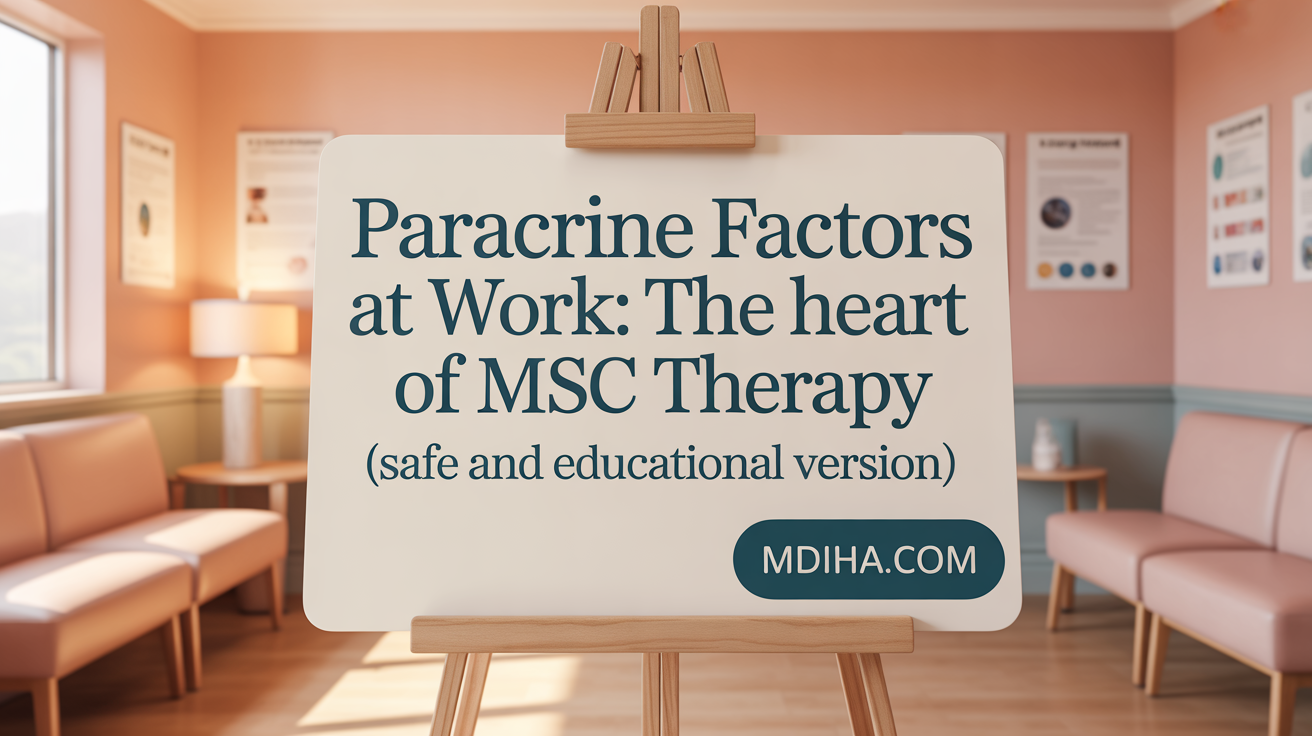
Secretion of growth factors and cytokines
Mesenchymal stromal cells (MSCs) exert their healing potential primarily through secreting a diverse array of bioactive molecules. These include growth factors like VEGF (vascular endothelial growth factor), HGF (hepatocyte growth factor), and FGF (fibroblast growth factor), which promote tissue survival, stimulate blood vessel formation, and support cellular regeneration. Cytokines such as IL-10 and TSG-6 are also pivotal, mediating anti-inflammatory effects and modulating immune responses to foster a conducive environment for healing.
Extracellular vesicles and exosomes carrying proteins and RNAs
MSCs release extracellular vesicles (EVs) and exosomes, which are nano-sized packages rich in proteins, messenger RNAs (mRNAs), and microRNAs. These vesicles are potent mediators of tissue repair, angiogenesis, and cell survival. They can transfer functional molecules directly to damaged or neighboring cells, thereby enhancing regenerative processes without the need for cell transplantation. This cell-free approach has attracted considerable interest for its safety and efficacy.
Mitochondrial transfer to damaged cells
An intriguing mechanism of MSC action involves the transfer of mitochondria to injured cells. This process helps restore the bioenergetics and metabolic function of damaged tissues, supporting cellular repair. Mitochondrial transfer can occur through tunneling nanotubes or cell-cell fusion, providing a direct means to rescue stressed cells and promote tissue regeneration.
Modulation of immune and stromal cell behavior
MSCs are highly effective immunomodulators. They influence both innate and adaptive immune responses by secreting anti-inflammatory proteins such as PGE2 and IL-10, and by affecting immune cell phenotypes. MSCs can shift macrophages from a pro-inflammatory M1 state to an anti-inflammatory M2 phenotype, which is crucial for resolving inflammation and supporting tissue repair. Additionally, they can alter the activity of T cells, B cells, and dendritic cells, creating a balanced immune environment favorable for healing.
Importance of localized delivery for efficacy
Delivering MSCs directly into target tissues enhances their paracrine effects. Localized administration ensures higher concentrations of therapeutic factors at the injury site, leading to more potent regeneration and reduced systemic side effects. Strategies such as priming MSCs, using biomaterials like hydrogels or patches, further improve cell retention, survival, and efficacy, making localized delivery a preferred approach for many regenerative applications.
MSC Homing and Migration: Targeted Delivery to Injury Sites

How do MSCs target injury sites?
Mesenchymal stromal cells (MSCs) have an innate ability to migrate towards damaged tissues, a process known as homing. This targeted migration is primarily driven by chemokine signaling pathways. Among these, the CXCR4 receptor on MSCs interacts with its ligand CXCL12 (also called SDF-1), which is highly expressed in injured tissues. This chemokine-receptor pair guides MSCs directly to sites needing repair.
What role do adhesion molecules play?
Once MSCs reach the vicinity of injury, adhesion molecules such as VCAM-1 and ICAM-1 facilitate their attachment to the endothelial lining of blood vessels. These molecules interact with integrins on MSC surfaces, like α4/β1 integrins, allowing MSCs to transmigrate through blood vessel walls and enter the tissue microenvironment.
How do hypoxia and cytokines affect MSC migration?
Inflammation and low oxygen (hypoxia), common in injured tissues, further influence MSC homing. Hypoxic conditions stimulate the expression of CXCL12, amplifying the chemotactic signals. Similarly, pro-inflammatory cytokines like IL-1β, TNF-α, and IFN-γ increase the expression of chemokine receptors and adhesion molecules on MSCs, enhancing their migration ability.
Why are these mechanisms important for therapy?
Understanding MSC homing is crucial for improving cell therapy efficiency. Strategies such as priming MSCs with inflammatory signals or modifying their receptor expression can enhance their retention at injury sites. Optimizing homing improves tissue regeneration outcomes and reduces the need for multiple injections, making treatment more effective and targeted.
| Mechanism | Key Molecules | Role in Migration | Clinical Implications |
|---|---|---|---|
| Chemokine signaling | CXCR4, CXCL12 | Guides MSCs to injury | Enhancing receptor expression improves homing |
| Adhesion and transmigration | VCAM-1, ICAM-1, integrins | Anchors MSCs and allows tissue entry | Modulating adhesion molecules can increase retention |
| Response to hypoxia and cytokines | HIF-1α, IL-1β, TNF-α, IFN-γ | Amplifies chemotaxis signals | Priming MSCs for specific microenvironments |
MSC-Derived Extracellular Vesicles: Cell-Free Therapies in Regenerative Medicine
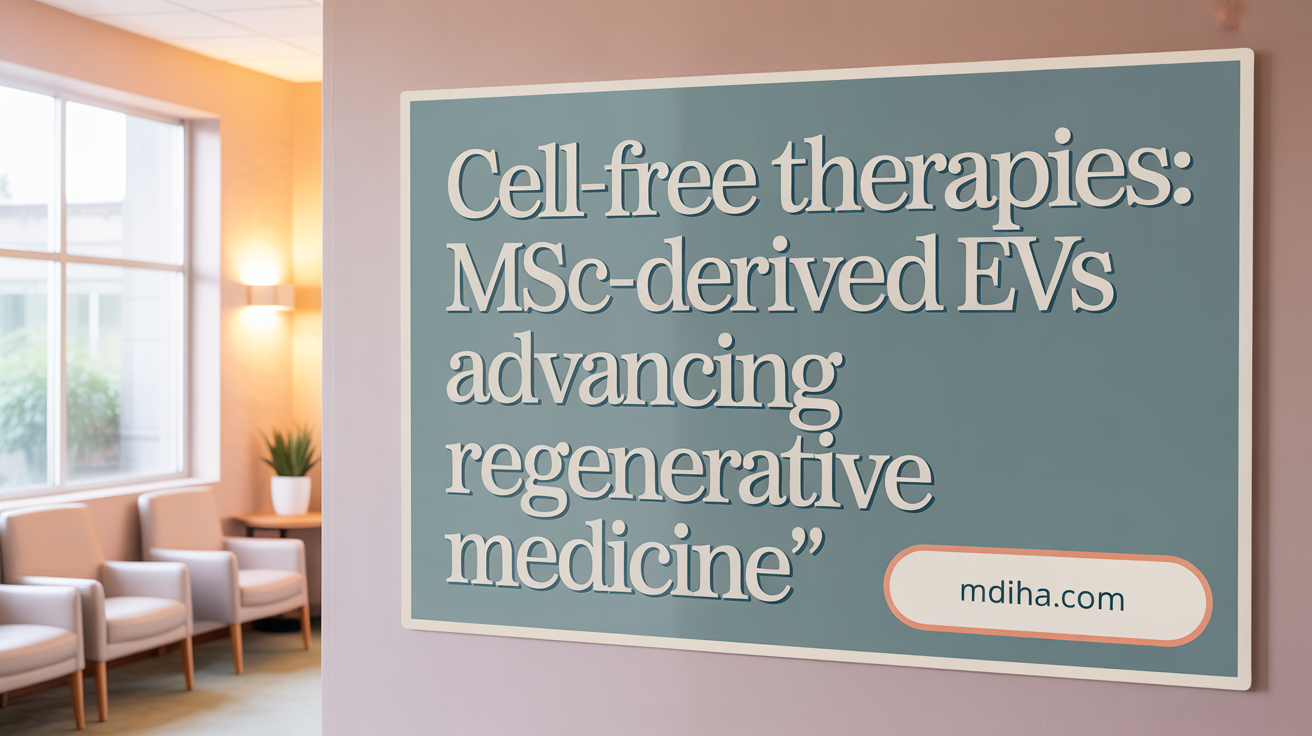
Composition and cargo of EVs and exosomes
Mesenchymal stromal cell (MSC)-derived extracellular vesicles (EVs) and exosomes are tiny, membrane-bound particles released by MSCs. These vesicles carry a rich cargo, including proteins, messenger RNAs (mRNAs), and microRNAs, which are crucial for their therapeutic effects. The proteins can include growth factors and cytokines, while their RNA content influences gene expression in recipient cells, facilitating tissue repair.
Mechanisms promoting angiogenesis, reducing apoptosis
EVs and exosomes from MSCs actively promote new blood vessel formation (angiogenesis), enabling improved blood flow to damaged tissues. They carry pro-angiogenic factors such as vascular endothelial growth factor (VEGF) and other molecules that stimulate endothelial cell proliferation. Additionally, these vesicles carry anti-apoptotic signals that help prevent programmed cell death, preserving tissue integrity during the healing process.
Potential advantages of cell-free MSC therapy
Using EVs and exosomes as therapy offers several benefits over cell-based treatments. Since they are acellular, there’s a reduced risk of immune rejection and tumor formation. EVs are also easier to store and handle, and their small size allows for better tissue penetration. Moreover, their ability to be engineered to enhance specific therapeutic molecules makes them highly adaptable tools in regenerative medicine.
Experimental and clinical findings supporting EV use
Research studies, both preclinical and clinical, support the therapeutic potential of MSC-derived EVs. In models of myocardial infarction, lung injury, and degenerative diseases, EVs have been shown to improve tissue survival, reduce inflammation, and enhance regeneration. Early clinical trials are exploring their safety and efficacy, with promising preliminary results indicating their role as effective, cell-free treatment options.
| Aspect | Details | Relevance |
|---|---|---|
| Composition | Proteins, mRNAs, microRNAs | Supports tissue repair, signaling |
| Promoting angiogenesis | VEGF, other growth factors | Enhances blood flow and healing |
| Reducing apoptosis | Anti-apoptotic molecules | Preserves damaged tissue |
| Advantages | Safety, storage, lower immune risk | Facilitates wider application |
| Supporting evidence | Animal models and early patient trials | Validates regenerative capacity |
Immunoregulatory Plasticity of MSCs: MSC1 and MSC2 Phenotypes
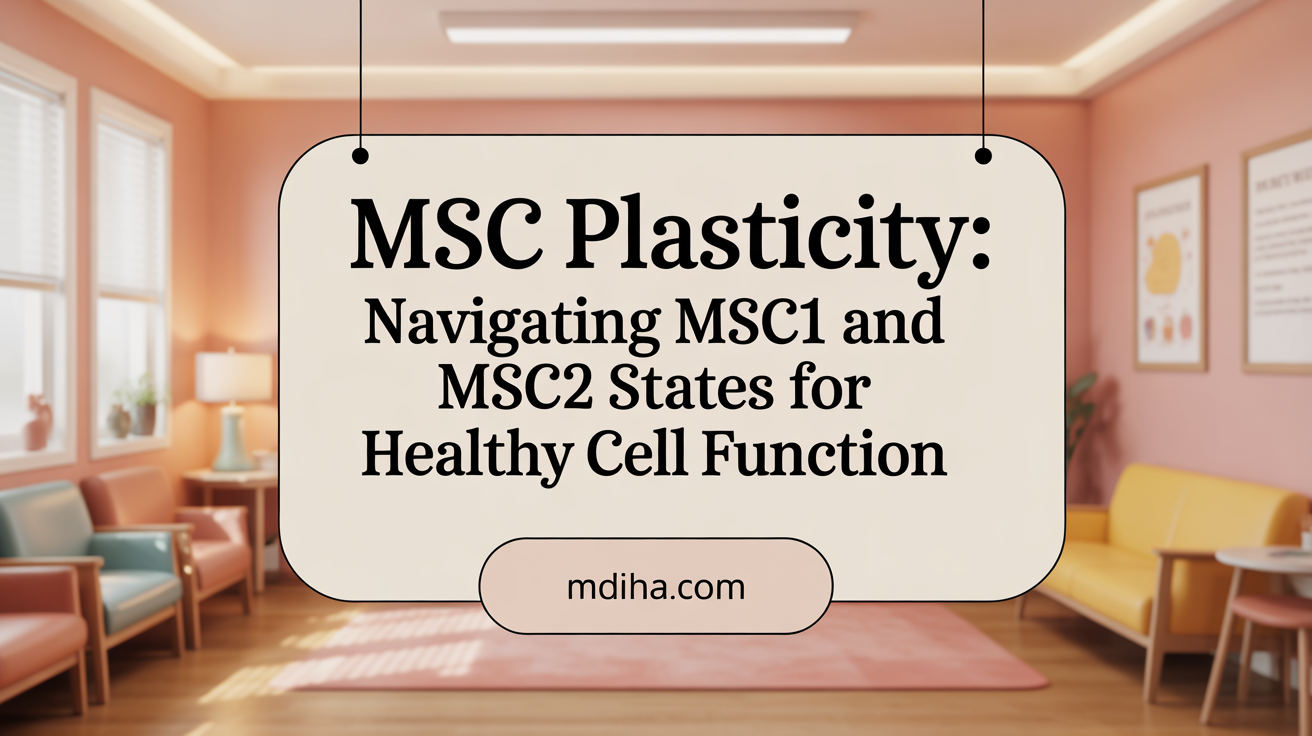
How does Toll-like receptor activation influence MSC phenotype?
When Toll-like receptors (TLRs) on mesenchymal stem cells (MSCs) are activated by microbial components or cytokines, they can cause MSCs to switch into different functional states. Activation of TLR4, for example, tends to promote a pro-inflammatory MSC1 phenotype, which secretes cytokines that stimulate immune responses. Conversely, TLR3 activation generally favors an anti-inflammatory MSC2 phenotype, which enhances immune suppression and tissue repair.
What are the differences between MSC1 and MSC2 in terms of inflammation?
MSCs can polarize into two main types based on the TLR signals they receive:
| Phenotype | Inflammatory Role | Typical Cytokines Produced | Therapeutic Implication |
|---|---|---|---|
| MSC1 | Pro-inflammatory | IL-6, IL-8, TNF-α | Might amplify immune response; less suitable for dampening chronic inflammation |
| MSC2 | Anti-inflammatory | IL-10, TGF-β, PGE2 | Favorable for reducing inflammation and promoting tissue healing |
This polarization influences how MSCs modulate immune functions during therapy.
How does this impact cytokine secretion and therapy?
MSC1 cells enhance inflammation by releasing cytokines that activate immune cells, potentially useful in cancer or infections. MSC2 cells secrete anti-inflammatory mediators, which are beneficial in treating autoimmune diseases and chronic inflammatory conditions. Understanding and manipulating this balance allows clinicians to tailor MSC therapies for safety and effectiveness.
Why is this relevant for therapeutic applications and safety?
The ability of MSCs to switch between MSC1 and MSC2 states provides a way to optimize treatments. Stimulating MSC2 phenotype can improve safety by reducing excessive immune activation and promoting regeneration. Conversely, caution is needed if MSC1 phenotype becomes dominant, which could exacerbate inflammation.
This plasticity underscores the importance of controlling MSC activation states during therapy to maximize benefits and minimize risks, contributing to the safe and effective use of MSCs in regenerative medicine.
Metabolic Adaptations in MSCs Governing Immunomodulation and Repair
How does MSC metabolism adapt under hypoxia and oxidative stress?
Mesenchymal stem cells (MSCs) are often found in tissues with low oxygen levels, especially during injury or inflammation. Under these hypoxic conditions, MSCs adapt by shifting their energy production pathways. They enhance glycolysis, which allows them to generate ATP efficiently despite limited oxygen, supporting cell survival and function.
Additionally, MSCs respond to oxidative stress by activating antioxidant defenses and modulating mitochondrial activity. This helps maintain cellular integrity and ensures their continued ability to secrete healing factors.
What roles do glycolysis, fatty acid oxidation, and mitochondrial function play?
Glycolysis is a central pathway for MSC energy production, especially in hypoxia. It supplies rapid ATP and supports biosynthesis needs. Fatty acid oxidation, on the other hand, can be upregulated to provide energy when oxygen is more available, aiding long-term cell maintenance.
Mitochondria are vital for energy production and signaling. Their function influences MSC proliferation, differentiation, and the ability to modulate immune responses. Under stress conditions, mitochondrial dynamics—fusion and fission—and biogenesis help MSCs adapt their metabolism efficiently.
How does MSC and immune cell metabolism interplay?
MSC and immune cell metabolism are interconnected, influencing immunosuppression and repair. For example, MSCs' shift toward glycolysis during inflammation supports the secretion of anti-inflammatory cytokines. Conversely, activated immune cells such as macrophages also reprogram their metabolism, with M1 macrophages relying on glycolysis and M2 macrophages depending on oxidative phosphorylation.
This metabolic crosstalk allows MSCs to influence immune cell polarization, promoting an anti-inflammatory environment necessary for tissue healing.
In what ways does this metabolic flexibility influence immunosuppressive capacity and cell survival?
MSCs' ability to modify their metabolism enhances their immunosuppressive functions. By adjusting to local oxygen and nutrient levels, MSCs maintain high viability and continue secreting trophic and anti-inflammatory factors. This metabolic plasticity ensures sustainable immunomodulation and tissue repair, even under adverse microenvironmental conditions.
In summary, MSCs' capacity to adapt metabolically to hypoxia and oxidative stress underpins their regenerative and immunomodulatory effects, making them effective in injury and inflammation therapies.
Enhancing MSC Therapeutic Efficacy: Priming, Biomaterials, and Genetic Modification
How can preconditioning MSCs with inflammatory cytokines improve their therapeutic effects?
Preconditioning MSCs with inflammatory cytokines such as IFN-γ, TNF-α, and IL-1β can enhance their immunomodulatory properties. This priming increases the secretion of anti-inflammatory factors like PGE2, IL-10, and TSG-6, which help regulate immune responses more effectively. This strategy boosts the cells' ability to suppress inflammation and supports tissue repair when administered to injury sites.
What role do biomaterials like hydrogels and patches play in local MSC delivery?
Using biomaterials such as hydrogels, microgels, and tissue patches allows for targeted and sustained release of MSCs directly at the injury site. These materials provide a protective environment that enhances cell retention, survival, and integration. For example, scaffolds can mimic the tissue microenvironment, promoting MSC differentiation and paracrine activity, leading to improved tissue regeneration.
How can genetic engineering enhance MSC survival and function?
Genetic modification of MSCs aims to increase their resilience and therapeutic potency. Techniques include overexpressing survival genes, angiogenic factors like VEGF, or anti-apoptotic proteins, which help MSCs withstand hostile microenvironments such as hypoxia and inflammation. This genetic tuning also directs MSCs to produce higher levels of beneficial trophic factors, amplifying their regenerative effects.
What strategies address poor cell retention and survival in MSC therapy?
To improve cell retention and longevity, researchers employ methods like priming MSCs with inflammatory stimuli, applying biomaterials for sustained delivery, and genetic modifications to resist apoptosis. Combining these approaches creates a synergistic effect, ensuring MSCs remain active longer within damaged tissues, thereby maximizing their healing potential.
| Strategy | Primary Benefit | Technical Approach | Additional Notes |
|---|---|---|---|
| Cytokine priming | Enhanced immunomodulation | Short-term exposure to cytokines | Boosts anti-inflammatory secretions |
| Biomaterial scaffolds | Improved retention & survival | Embedding MSCs in hydrogels or patches | Mimics tissue microenvironment |
| Genetic modification | Increased resilience & trophic factor production | Overexpression of survival or angiogenic genes | Tailored for specific tissue needs |
| Combined approaches | Synergistic improvements | Integrating priming, biomaterials, and genetic tools | Promising for complex injury treatments |
Understanding and implementing these strategies can significantly enhance the effectiveness of MSC therapy, making treatments more reliable and potent in tissue repair and inflammation management.
Clinical Applications of MSCs in Treating Inflammatory and Injurious Conditions

What are the clinical applications and challenges of mesenchymal stem cell therapies in treating injury and inflammatory diseases?
Mesenchymal stem cells (MSCs) have demonstrated significant potential in clinical settings for managing a wide range of injury and inflammation-related conditions. They are utilized in treating graft-versus-host disease (GVHD), inflammatory bowel diseases (such as Crohn’s disease and ulcerative colitis), acute inflammatory states like sepsis, and severe pulmonary diseases including COVID-19-related acute respiratory distress syndrome (ARDS). These applications leverage MSCs' abilities to modulate immune responses, promote tissue repair, and reduce inflammation.
In GVHD, MSC infusions have improved response rates and survival, particularly in pediatric cases resistant to steroids. For inflammatory bowel diseases, MSCs help regulate immune responses by increasing regulatory T cells and decreasing pro-inflammatory cytokines, leading to symptom alleviation and mucosal healing. In sepsis and severe lung conditions, MSCs have been shown to decrease mortality and inflammation, supporting their role as a therapy for acute inflammatory crises.
Despite promising outcomes, several challenges hinder the widespread adoption of MSC therapies. One major issue is the heterogeneity of MSC populations, which vary depending on donor age, tissue source, and cell culture techniques. This variability affects safety, effectiveness, and reproducibility across different batches. Additionally, MSC survival post-infusion is often limited, reducing their therapeutic potency.
Manufacturing MSCs involves complex processes with potential safety concerns, including the risk of tumor formation and immunogenic reactions. Standardizing protocols for cell isolation, expansion, and storage remains a hurdle. Researchers are investigating strategies such as genetic modification to enhance cell survival, priming cells with inflammatory signals to boost efficacy, and utilizing MSC-derived extracellular vesicles (EVs) as cell-free therapeutic agents to circumvent some safety issues.
Overall, ongoing research aims to optimize MSC treatment protocols, improve safety profiles, and develop standardized manufacturing procedures. These efforts are crucial for translating the promising preclinical and clinical results into widely accessible, effective therapies for inflammatory and injury-related diseases.
MSCs in Osteoarthritis: Regulating Inflammation and Promoting Cartilage Repair
How does inflammation contribute to osteoarthritis progression?
Osteoarthritis (OA) is a degenerative joint disease characterized by cartilage breakdown, bone changes, and inflammation of the synovium. Inflammation plays a central role in OA progression by involving cytokines like TNF-α, IL-1β, and IL-6, which cause cartilage degradation and joint pain. This inflammatory environment attracts immune cells and perpetuates tissue damage, making inflammation a crucial therapeutic target.
What growth factors do MSCs secrete to aid tissue repair?
Mesenchymal stromal cells (MSCs) are known for secreting a variety of trophic factors that support tissue healing and repair. These include Transforming Growth Factor-beta (TGFβ), Hepatocyte Growth Factor (HGF), Fibroblast Growth Factor (FGF), and Vascular Endothelial Growth Factor (VEGF). These molecules stimulate cartilage regeneration, enhance angiogenesis, and promote the survival and proliferation of chondrocytes, aiding in restoring damaged joint tissue.
How do MSCs exert anti-inflammatory effects?
MSCs actively reduce joint inflammation through the secretion of anti-inflammatory mediators such as Interleukin-1 Receptor Antagonist (IL1RA). They modulate immune responses by influencing macrophage phenotypes, shifting them from pro-inflammatory (M1) to anti-inflammatory (M2) states. This immune modulation diminishes the production of destructive cytokines and fosters a reparative environment within the joint.
What clinical evidence supports the safety and effectiveness of MSC therapy in osteoarthritis?
Clinical trials have largely demonstrated that MSC-based treatments are safe for OA patients, with minimal adverse effects due to their autologous origin. Patients have experienced improvements in pain, joint function, and quality of life. Several studies report cartilage regeneration and reduced inflammation post-treatment, highlighting MSCs as a promising adjunct or alternative to traditional therapies.
Are there differences among MSC sources in their potential for cartilage regeneration?
Yes, MSCs derived from different tissues vary in their chondrogenic capacity. Bone marrow-derived MSCs often exhibit higher potential for cartilage formation compared to adipose tissue or umbilical cord MSCs. These differences influence the choice of cell source for specific clinical applications, with bone marrow MSCs generally preferred for cartilage regeneration therapies.
| Aspect | Source | Chondrogenic Potential | Notes |
|---|---|---|---|
| Bone marrow MSCs | Bone marrow | High | Widely used in cartilage repair studies |
| Adipose tissue MSCs | Fat tissue | Moderate | Abundant and easier to harvest |
| Umbilical cord MSCs | Perinatal tissue | Variable | Younger cells, less invasive harvest |
Understanding the interaction of MSCs with the inflammatory joint environment and optimizing their secretory profile can greatly enhance their therapeutic success in osteoarthritis, providing both symptom relief and tissue restoration.
Mesenchymal Stem Cells and Tumor Microenvironment Interactions
How do MSCs play dual roles in tumor growth?
Mesenchymal stem cells (MSCs) have a complex relationship with tumors, acting as double-edged swords. In some scenarios, naïve MSCs can inhibit tumor growth by secreting factors that suppress proliferation, induce apoptosis, or inhibit angiogenesis. Conversely, tumor-educated MSCs within the tumor microenvironment often promote cancer progression. They can facilitate tumor growth by supporting blood vessel formation, enhancing cancer cell survival, and preparing a supportive niche.
What is the influence of tumor-educated MSCs?
Tumor-educated MSCs (T-MSCs) are MSCs that have been conditioned by interactions with malignant cells and inflammatory signals. These MSCs tend to support tumor progression by secreting cytokines, growth factors, and extracellular vesicles tuned to promote angiogenesis, immune evasion, and epithelial-mesenchymal transition (EMT). This education process often converts MSCs into tumor-promoting agents, supporting the cancer's invasive and metastatic potential.
How are MSCs recruited to tumor sites?
MSCs are attracted to tumors through signals from the inflammatory environment, involving cytokines like TNF-α and IL-6, as well as chemokines such as CXCL12 (SDF-1). They express chemokine receptors like CXCR4, which respond to these chemotactic signals, guiding MSC migration to the tumor. This recruitment is mediated by adhesion molecules such as VCAM-1 and integrins, which facilitate MSC attachment and infiltration into tumor tissue.
How do MSCs affect tumor angiogenesis and EMT?
MSCs contribute significantly to tumor angiogenesis by secreting vascular growth factors, including VEGF, FGF, and PDGF. These factors stimulate the formation of new blood vessels, which supply the tumor with nutrients and oxygen. Additionally, MSCs can promote epithelial-mesenchymal transition (EMT), a process where cancer cells gain migratory and invasive properties. MSCs release cytokines and extracellular vesicles that induce EMT, thus facilitating tumor metastasis.
What are the therapeutic implications of targeting MSCs in cancer?
Understanding the dual roles of MSCs in tumors opens avenues for novel cancer therapies. Strategies include inhibiting tumor-educated MSC recruitment, blocking their pro-tumorigenic secretions, or reprogramming MSCs to support anti-tumor immunity. Since MSCs also serve as delivery vehicles for anti-cancer agents, engineering them to carry therapeutic molecules is a promising approach. Targeting the MSC-tumor interaction thus offers potential to suppress tumor progression and improve treatment outcomes.
MSC and Macrophage Interactions in Tissue Injury and Repair
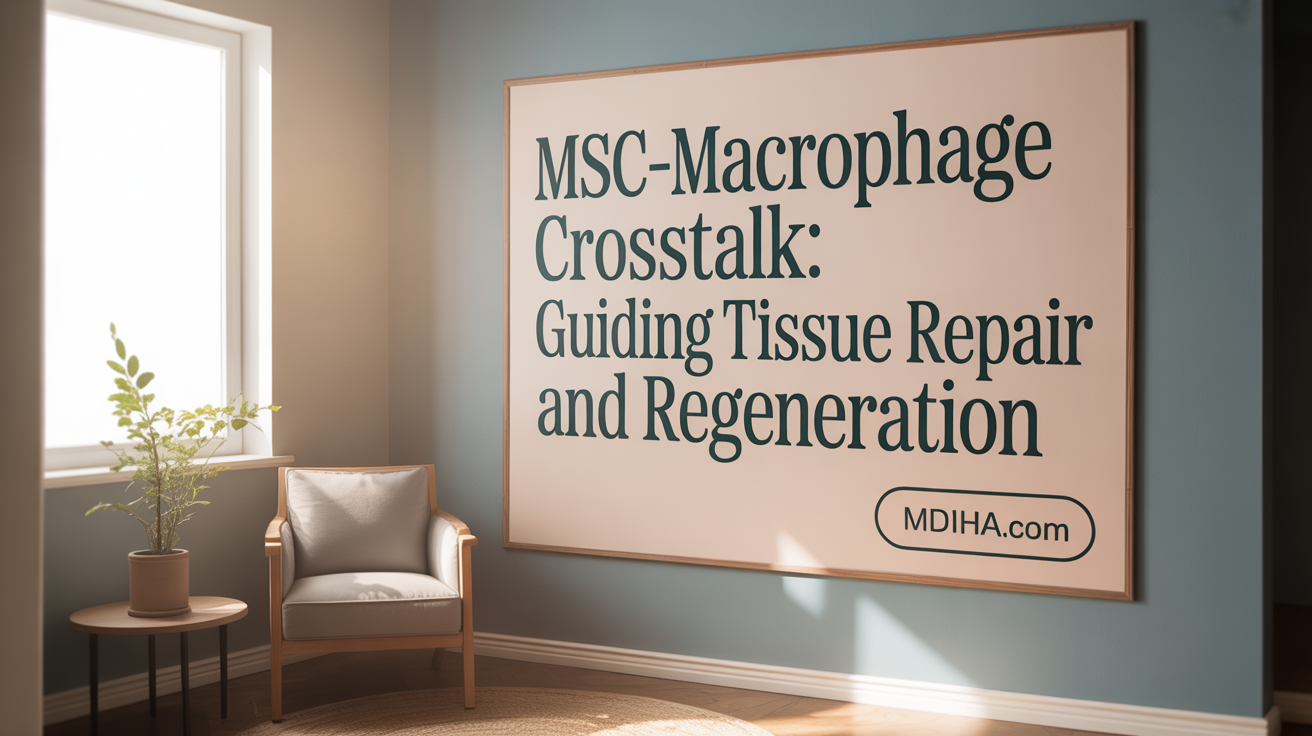
How do reciprocal crosstalk and signaling influence the secretory profiles of MSCs and macrophages?
Mesenchymal stem cells (MSCs) and macrophages communicate closely during tissue healing, primarily through their secreted factors. MSCs secrete cytokines and growth factors like TGF-β, VEGF, and PGE2, which influence macrophages to adopt a reparative phenotype. Conversely, activated macrophages release inflammatory cytokines such as TNF-α and IL-1β that can prime MSCs to enhance their anti-inflammatory and regenerative functions. This bidirectional interaction ensures a balanced environment that fosters tissue repair and resolves inflammation.
How does macrophage polarization from M1 to M2 promote healing?
Macrophage polarization is crucial in tissue regeneration. M1 macrophages are pro-inflammatory and dominate during initial injury response, clearing debris and pathogens. Transitioning to M2 macrophages, which have anti-inflammatory and tissue reparative functions, is essential for healing. MSCs support this shift by releasing factors like IL-10 and PGE2, promoting M2 polarization. This change suppresses ongoing inflammation, facilitates angiogenesis, and stimulates tissue remodeling.
How do macrophages and MSCs modulate inflammation and promote repair in injured tissues?
Both cell types deploy immunomodulatory strategies to control inflammation. MSCs secrete anti-inflammatory cytokines and induce macrophages to produce IL-10-rich M2 phenotypes. Macrophages, in turn, clear apoptotic cells and release factors that support MSC survival and function. Together, they orchestrate a transition from damaging inflammation to constructive repair, reducing scar formation and enhancing tissue regeneration.
What is the impact of macrophages on MSC viability and function?
Macrophages influence MSC viability through direct contact and their secreted molecules. M2 macrophages release growth factors like TGF-β that sustain MSC survival and trophic activity. The inflammatory environment, mediated by M1 macrophages, can initially hinder MSC function but, with proper modulation, macrophages support MSC differentiation and secretion activities, critical for effective tissue repair.
What are the therapeutic implications of MSC-macrophage interactions in spinal cord injury and other damages?
Harnessing the interaction between MSCs and macrophages holds promise for treating injuries like spinal cord trauma. MSCs can reprogram macrophages toward an anti-inflammatory profile, reducing damage and promoting nerve regeneration. Preconditioning MSCs or modulating macrophages can amplify healing processes, potentially restoring function after severe injuries. Understanding these dynamics paves the way for optimized cell therapies that leverage immune system modulation for better clinical outcomes.
| Topic | Key Points | Additional Details |
|---|---|---|
| Crosstalk influence | Bidirectional secretion modulates behavior | MSCs secrete TGF-β, PGE2; macrophages release cytokines |
| Macrophage roles | M1 for inflammation, M2 for repair | Transition driven by MSCs and cytokines |
| Inflammation and repair | MSCs and macrophages coordinate resolution | Suppression of inflammation supports tissue healing |
| Macrophages on MSCs | Support survival, differentiation | M2 macrophages sustain MSC function |
| Therapeutic potential | Targeted cell strategies | Enhancing MSC-macrophage communication improves repair outcomes |
Neural Regeneration Supported by MSCs: Mechanisms and Clinical Insights
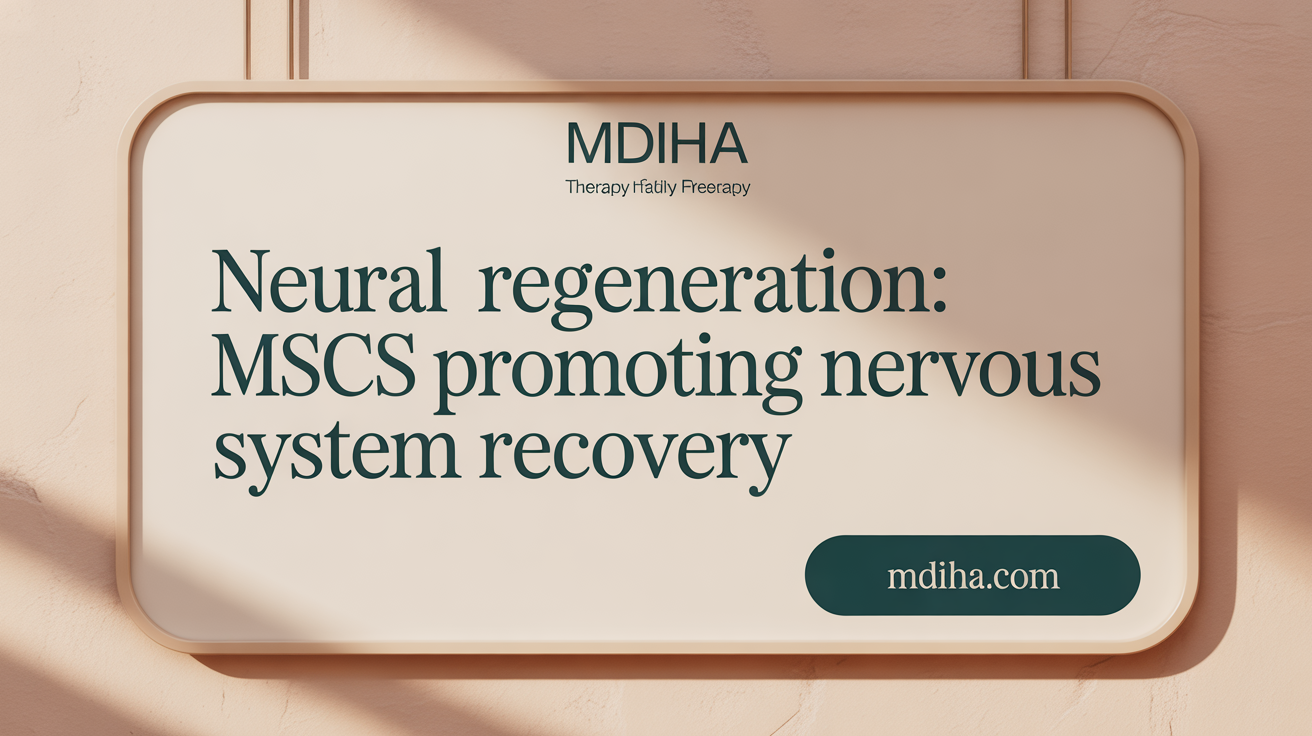
How do MSCs promote neural regeneration?
Mesenchymal stem cells (MSCs) support nerve repair primarily through secreting neurotrophic factors like brain-derived neurotrophic factor (BDNF) and nerve growth factor (NGF). These molecules are vital for neuron survival, growth, and differentiation. By releasing these factors, MSCs help protect existing neural tissue from degeneration and foster the growth of new nerve fibers.
How do MSCs modulate glial scarring and support axonal growth?
In cases of neural injury, glial scar formation can hinder nerve regeneration. MSCs help reduce this inhibitory scar formation by secreting anti-inflammatory and tissue-degrading molecules. This action creates a more permissive environment that promotes axonal regeneration and reconnects neural pathways.
What role does MSC-induced angiogenesis play in neural tissue repair?
MSC secretion of angiogenic factors like VEGF, FGF, and PDGF stimulates new blood vessel formation within the injured neural tissue. Enhanced vascularization improves oxygen and nutrient delivery, essential for neural cell survival and regeneration.
What evidence exists from preclinical and clinical studies for MSC use in neural disorders?
Preclinical studies with animal models show that MSC transplantation can improve motor and sensory functions in spinal cord injury (SCI), amyotrophic lateral sclerosis (ALS), and Parkinson’s disease. Clinically, early trials report safety and some functional benefits, such as improved mobility and reduced pain.
What is the safety profile and what outcomes are observed?
MSCs are generally considered safe, especially when autologous cells are used, with minimal adverse effects reported. Patients often experience improved neurological functions, reduced inflammation, and better quality of life after MSC therapy.
| Application Area | Evidence Level | Observed Outcomes | Notes |
|---|---|---|---|
| Spinal Cord Injury | Preclinical & Early Clinical | Motor recovery, nerve regeneration | Promising but ongoing research |
| ALS | Preclinical | Neuroprotective effects | Still experimental |
| Parkinson’s | Preclinical | Improved motor function | Clinical trials underway |
Harnessing the regenerative and immunomodulatory properties of MSCs holds promising potential for advancing neural injury treatments. Ongoing clinical trials continue to explore optimal methods and long-term outcomes.
MSC Contributions to Liver, Kidney, Heart, and Bone Regeneration
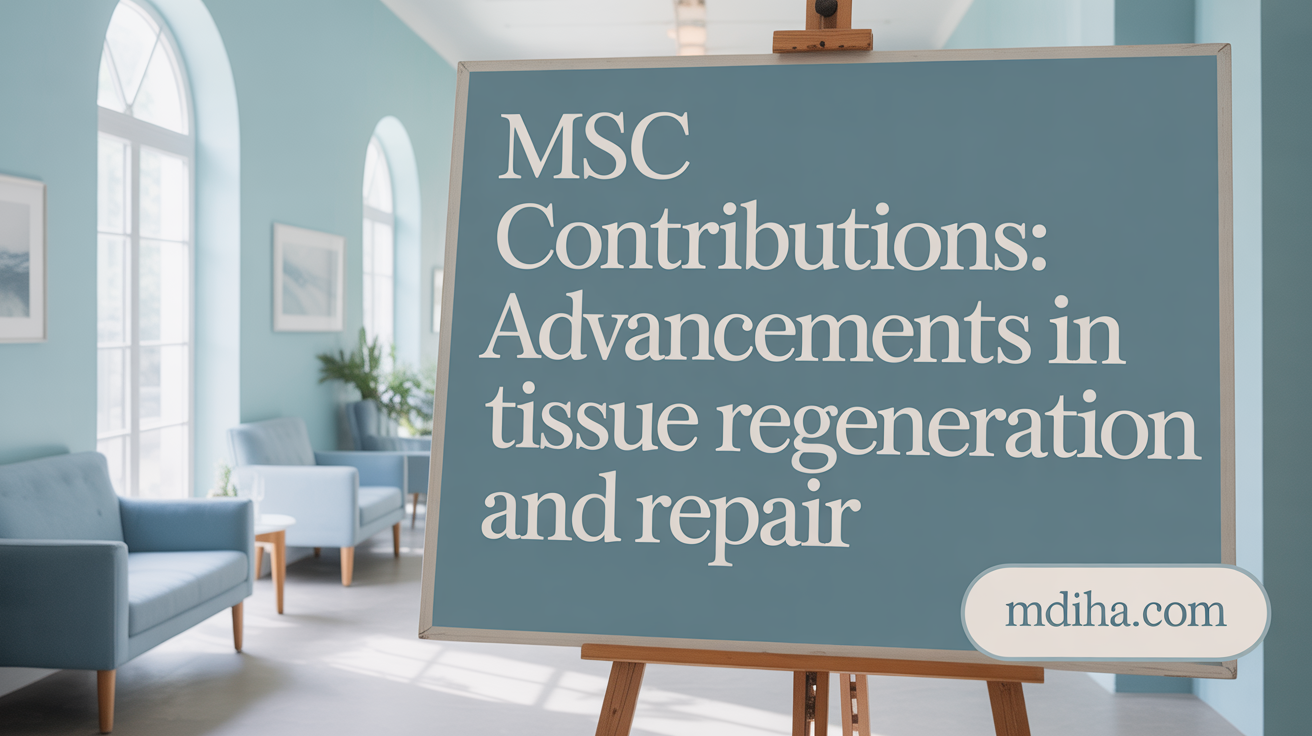
Applications in cirrhosis and acute liver failure
Mesenchymal stem cells (MSCs) have shown promise in liver regeneration therapies. In conditions such as cirrhosis and acute-on-chronic liver failure, MSCs can reduce fibrosis and improve liver function. They secrete growth factors like HGF and VEGF that promote tissue repair and angiogenesis, helping restore normal liver architecture. Clinical trials report that MSC treatment can lead to decreased liver fibrosis and enhanced regeneration, making MSCs a potential adjunct or alternative to traditional therapies.
Kidney injury and chronic disease benefits via blood flow and function
In kidney regeneration, MSCs contribute to repairing damaged tissues in both chronic and acute kidney diseases. They enhance blood flow, support cellular regeneration, and help restore renal function. MSC-secreted factors such as IGF-1 and HGF support renal cell survival and proliferation. Studies in animal models and early clinical trials suggest MSCs can mitigate inflammation, reduce scarring, and improve filter function, holding potential for treating conditions like chronic kidney disease and acute injury.
Cardiac repair after myocardial infarction and heart failure
MSCs are extensively studied for cardiac repair post-myocardial infarction and in cases of heart failure. They secrete angiogenic factors such as VEGF and FGF, which promote new blood vessel formation, crucial for restoring oxygen supply to damaged heart tissue. MSCs also release anti-apoptotic and cardioprotective molecules that support tissue survival and improve cardiac function. Clinical evidence indicates improvements in heart pumping capability and patient quality of life after MSC therapy, with ongoing research aiming at optimizing delivery and efficacy.
Bone healing, osteoporotic fracture repair, and osteoarthritis
MSCs play a pivotal role in bone regeneration. They can differentiate into osteocytes, promoting fracture healing and repairing osteoporotic fractures effectively. In osteoarthritis (OA), MSCs support cartilage repair and reduce joint inflammation by secreting growth factors like TGF-β and VEGF. Preclinical and clinical studies demonstrate that MSC treatments can reduce cartilage degradation, improve joint function, and alleviate pain. Their ability to foster tissue regeneration makes MSCs promising for managing skeletal injuries and degenerative joint diseases.
| Application Area | Benefits | Mechanisms of Action |
|---|---|---|
| Liver disease | Reduces fibrosis, improves function | Secretion of HGF, VEGF, supporting regeneration |
| Kidney disease | Restores blood flow, reduces scarring | IGF-1, HGF promoting cell survival |
| Cardiac repair | Enhances angiogenesis, reduces apoptosis | VEGF, FGF, anti-inflammatory molecules |
| Bone & joint | Promotes osteogenesis, cartilage repair | Differentiation into osteocytes, secretion of growth factors |
Overall, MSCs offer a versatile approach for tissue regeneration across various organs, driven by their ability to secrete trophic factors, promote angiogenesis, and differentiate into target tissue cells.
MSC Use in Wound Healing: Anti-inflammatory and Trophic Effects
How do MSCs modulate chronic wound inflammation?
Mesenchymal stromal cells (MSCs) play a crucial role in reducing persistent inflammation in chronic wounds. They respond to inflammatory signals like cytokines and chemokines by secreting anti-inflammatory proteins such as IL-10, TSG-6, and PGE2. These factors help shift immune responses from pro-inflammatory to anti-inflammatory, promoting a calmer wound environment.
MSCs also influence innate immune cells, encouraging macrophages to polarize from the harmful M1 phenotype to the healing M2 phenotype. This cytokine-driven transition diminishes further tissue damage and prepares the wound bed for repair.
How do MSCs promote dermal reconstruction and epithelialization?
MSCs support the rebuilding of skin layers by secreting a variety of growth factors, including VEGF, HGF, and FGF. These promote new blood vessel formation (angiogenesis), enhance cellular proliferation, and stimulate tissue regeneration.
Additionally, MSCs release extracellular matrix components that provide structural support, facilitating the migration and organization of skin cells necessary for effective epithelialization.
What do MSCs secrete to aid tissue repair?
MSCs secrete a broad array of trophic factors, such as transforming growth factor-beta (TGF-β), insulin-like growth factor (IGF-1), and stromal cell-derived factor 1 (SDF-1). These molecules promote cellular proliferation, angiogenesis, and extracellular matrix remodeling.
They also produce extracellular vesicles like exosomes, which carry proteins, microRNAs, and mRNAs that further stimulate tissue regeneration, decrease apoptosis, and modulate immune responses.
How do MSCs reduce scar tissue formation and fibrosis?
By secreting anti-fibrotic factors like hepatocyte growth factor (HGF) and modulating cytokine profiles, MSCs help prevent excessive extracellular matrix deposition that leads to scarring.
Their ability to balance collagen production and remodeling encourages healthier tissue architecture, thus reducing scar tissue and fibrosis, resulting in more functional tissue repair.
Why are MSCs relevant in clinical repair of skin and vocal fold injuries?
Clinically, MSCs have shown promising results in treating skin wounds and vocal fold injuries. Their dual action of reducing inflammation and supporting regeneration accelerates healing, minimizes scarring, and restores tissue function.
In skin wounds, MSC therapy leads to faster closure and improved skin quality. In vocal fold injuries, MSCs help reduce scarring and restore vocal fold vibration, improving voice outcomes.
| Aspect | Key Contribution | Additional Details |
|---|---|---|
| Chronic wound inflammation | Modulation towards healing response | Secretion of anti-inflammatory cytokines and immune cell polarization |
| Dermal reconstruction | Support via growth factors and ECM | VEGF, HGF, FGF, extracellular matrix components |
| Growth factor secretion | Promotes angiogenesis and cell growth | TGF-β, IGF-1, SDF-1 |
| Scar and fibrosis prevention | Balances collagen production | HGF secretion, modulation of cytokines |
| Clinical applications | Skin and vocal fold repair | Faster healing, reduced scarring, improved tissue function |
Through these mechanisms, MSCs contribute significantly to effective wound healing and tissue restoration, emphasizing their potential in regenerative medicine.
Safety and Effectiveness of MSC Therapies in Clinical Settings
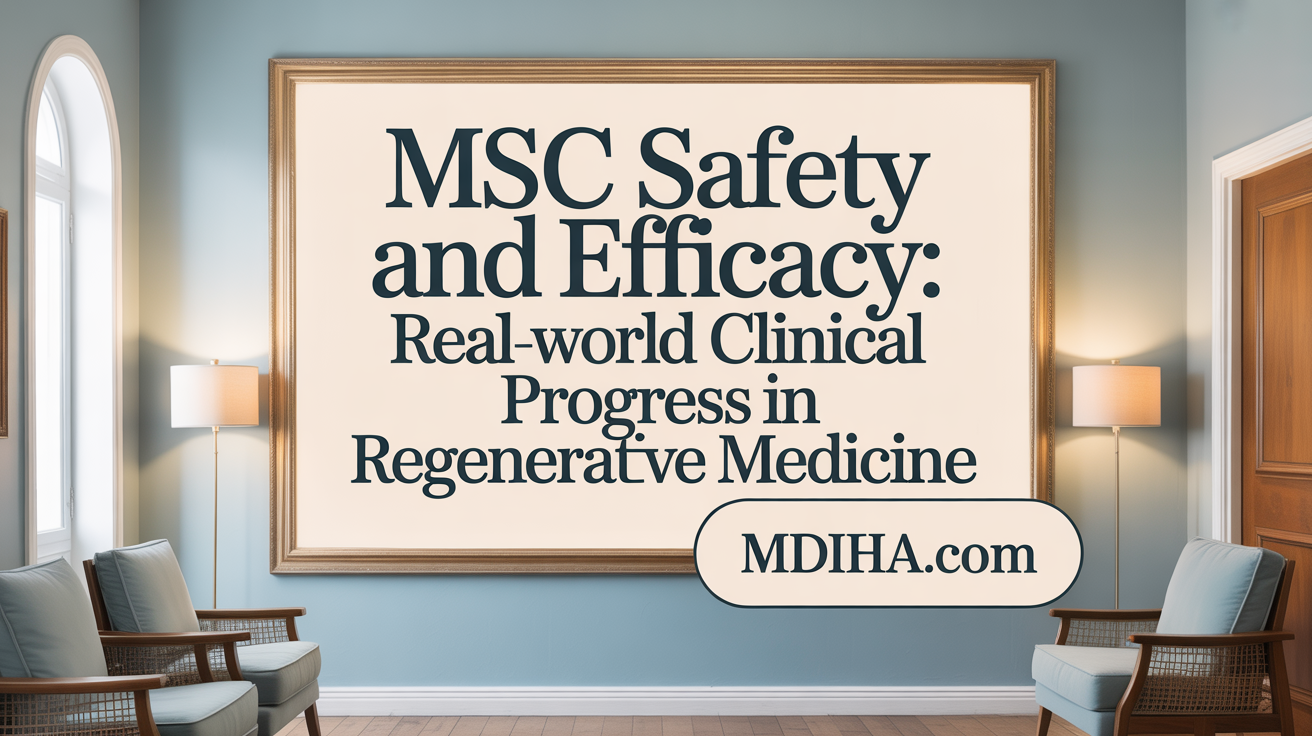
Evidence from clinical trials across diseases
Mesenchymal stromal cell (MSC) therapies have been extensively studied in clinical trials targeting various inflammatory and degenerative diseases. These trials have demonstrated promising effects, such as improved response rates in steroid-resistant graft-versus-host disease (GVHD), enhanced liver function in cirrhosis, and better joint function in osteoarthritis. Notably, in neural regeneration, MSC applications have shown safety profiles and some efficacy in conditions like spinal cord injuries and neurodegenerative diseases. Overall, these clinical results support the potential of MSCs as a versatile therapeutic tool.
Low immunogenicity and rejection risks
One of the advantages of MSCs is their low immunogenicity. They typically express low levels of MHC class I and lack co-stimulatory molecules, which allows them to be used allogeneically with minimal rejection risk. This immunoprivileged status facilitates their widespread application across various patients without the need for strict matching. Moreover, their ability to modulate immune responses contributes to their safety in transplantation and reduces the likelihood of adverse immune reactions.
Adverse event profiles and tumorigenicity concerns
MSCs have demonstrated a strong safety profile in clinical trials, with very few adverse events reported. Unlike some cell therapies, MSC treatments do not show significant tumor formation risks, partly due to their limited proliferative capacity and controlled differentiation. Nonetheless, ongoing long-term studies continue to monitor for any tumorigenicity, especially given the cells' capacity for differentiation and paracrine activity. Currently, the evidence suggests that MSCs are safe, but vigilance remains essential.
Long-term outcomes and therapeutic durability
Research indicates that MSC therapies can provide sustained benefits, including long-term tissue repair, immune regulation, and symptom alleviation. For instance, in chronic wound healing and autoimmune conditions, patients have experienced durable improvements. However, the longevity of these effects might depend on factors such as disease state, dosing, and delivery method. Therefore, optimizing these parameters is critical to prolong therapeutic benefits.
Optimizing dosing and delivery modalities
To maximize therapeutic efficacy, various strategies are employed, including priming MSCs, use of biomaterials like hydrogels or patches, and genetic modifications. Local administration frequently yields more potent and targeted effects compared to systemic delivery. Dosing regimens are tailored based on the condition being treated, with considerations for cell number, frequency of administration, and delivery route. These approaches aim to enhance MSC retention, survival, and paracrine activity, ultimately improving patient outcomes.
MSCs’ Immunosuppressive Molecules and Their Roles in Inflammation Control
What molecules do MSCs secrete to suppress inflammation?
MSCs release a variety of molecules that help regulate immune responses and reduce inflammation. Among these are TSG-6, PGE2, IL-10, TGF-β, IDO, and nitric oxide.
TSG-6 (Tumor Necrosis Factor-stimulated Gene-6) acts as an anti-inflammatory protein that can stabilize tissue environments. PGE2 (Prostaglandin E2) helps reprogram immune cells like macrophages into a healing and anti-inflammatory state.
IL-10 and TGF-β (Transforming Growth Factor-beta) are cytokines that suppress immune activation and promote regulatory immune cell development. IDO (Indoleamine 2,3-dioxygenase) breaks down tryptophan, an amino acid essential for T cell proliferation, thereby dampening T cell responses. Nitric oxide, produced by MSCs particularly in mice, also inhibits T cell activity.
How do these molecules affect T cells?
The secreted molecules from MSCs exert a potent subset of effects on T cells. They can cause T cell cycle arrest, induce apoptosis, and reduce the proliferation of effector T cells.
Furthermore, these molecules promote the generation and expansion of regulatory T cells (Tregs), which are essential for maintaining immune tolerance and resolving inflammation.
What is the impact on other immune cells?
MSCs' secretions not only suppress T cells but also inhibit the maturation of dendritic cells, reducing their ability to activate T cells further.
They can also suppress Natural Killer (NK) cell cytotoxicity and B cell activation, broadening their immunomodulatory scope.
How do MSCs interact with innate and adaptive immunity?
MSCs are capable of sensing inflammatory signals, like cytokines from injured tissues. In response, they secrete immunosuppressive molecules that shift immune cell populations towards anti-inflammatory phenotypes.
This dynamic interaction helps in controlling excessive immune responses, fostering a conducive environment for tissue repair. Their ability to modulate both innate cells (macrophages, NK cells) and adaptive cells (T, B cells) makes MSCs promising for treating inflammatory and auto-immune conditions.
Sources and Heterogeneity of MSCs: Implications for Therapy
What are the different sources of mesenchymal stem cells (MSCs)?
MSCs can be isolated from various tissues such as bone marrow, adipose tissue, umbilical cord, and placenta. Each source offers unique advantages and properties relevant to therapeutic uses.
Table 1: MSC Sources and Characteristics
| Source | Differentiation Potential | Common Uses | Additional Details |
|---|---|---|---|
| Bone marrow | High chondrogenic potential | Bone, cartilage repair | Most studied source, invasive harvest method |
| Adipose tissue | Strong angiogenic effects | Wound healing, cartilage regeneration | Abundant, easy to harvest, usually higher yield |
| Umbilical cord | High proliferation rate | Neural, cardiovascular, immune disorders | Non-invasive collection; youthful cell profile |
| Placenta | Multipotent, immunomodulatory | Regenerative medicine | Rich in MSCs, disposable after birth |
How does the source of MSCs influence their capabilities?
MSCs from different tissues show variability in their ability to differentiate into specific cell types like bone, cartilage, or nerve tissue. For example, bone marrow MSCs often excel in cartilage regeneration, while umbilical cord MSCs demonstrate superior proliferation.
What about their immunomodulatory capacities?
Source tissue impacts how MSCs modulate immune responses. For instance, MSCs from adipose tissue tend to secrete more angiogenic factors, while those from umbilical cords have higher proliferative and immunosuppressive properties.
How do culture conditions affect MSC properties?
Environmental factors such as oxygen levels, presence of inflammatory signals, and culture media composition can influence MSC behavior. For example, hypoxic conditions can enhance secretion of angiogenic factors, and cytokine priming can boost immunomodulatory functions.
Summary Table: Effects of Source and Conditions on MSCs
| Factor | Effect on MSCs | Implication for Therapy |
|---|---|---|
| Tissue source | Variability in differentiation and immunomodulation | Customization based on desired outcome |
| Hypoxic culture | Increased angiogenic factor secretion | Enhances tissue repair in ischemic conditions |
| Cytokine priming | Elevated anti-inflammatory and immunosuppressive activity | Better targeting of inflammation-related injuries |
Understanding these differences helps optimize MSC therapy to match specific clinical needs, ensuring more effective and tailored regenerative strategies.
MSC Activation and Priming: Cytokine-Induced Enhancement of Therapeutic Functions
Role of IFN-γ, TNF-α, IL-1β in MSC activation
Mesenchymal stem cells (MSCs) are highly responsive to their environment. When exposed to inflammatory cytokines like interferon-gamma (IFN-γ), tumor necrosis factor-alpha (TNF-α), and interleukin-1 beta (IL-1β), MSCs become activated and exhibit enhanced therapeutic capabilities.
These cytokines serve as signals that alert MSCs to tissue injury or inflammation, prompting them to adapt their behavior accordingly.
Upregulation of immunosuppressive factors (NO, IDO, PGE2)
Upon activation, MSCs increase the production of key immunosuppressive molecules such as nitric oxide (NO), indoleamine 2,3-dioxygenase (IDO), and prostaglandin E2 (PGE2). These factors help MSCs modulate immune responses by suppressing the activity of T cells, B cells, and natural killer (NK) cells.
This immunosuppressive response reduces inflammation and prevents further tissue damage, creating a more favorable environment for healing.
Shifts in secretory profiles toward anti-inflammatory states
In response to cytokine stimulation, MSCs shift their secretory profile towards producing anti-inflammatory cytokines like IL-10 and TSG-6. This switch enhances their ability to resolve inflammation, promote tissue repair, and support regeneration.
Their enhanced secretory activity includes releasing extracellular vesicles and exosomes loaded with restorative biomolecules, further amplifying their therapeutic effects.
Benefits for enhancing clinical effectiveness
Cytokine priming of MSCs improves their survival, homing ability, and the potency of their secreted factors. This approach increases the efficacy of MSC therapies in various clinical settings, including inflammatory and degenerative diseases.
By optimizing MSC activation through cytokine priming, clinicians can harness a more robust and targeted regenerative response, potentially leading to better patient outcomes and faster recovery in injury and inflammation management.
Extracellular Matrix Components Secreted by MSCs and Their Role in Tissue Repair
What are ECM molecules facilitating cell adhesion and niche formation?
Mesenchymal stromal cells (MSCs) secrete extracellular matrix (ECM) molecules that are crucial for establishing a supportive environment for tissue repair. These ECM components include fibronectin, collagen, and laminins, which serve as scaffolds that anchor cells, promote cell migration, and facilitate tissue organization.
How do ECM molecules support tissue remodeling and regeneration?
These secreted ECM proteins provide structural support that guides new tissue growth. They also interact with growth factors, enhancing their stability and bioavailability. This synergy promotes angiogenesis, cell proliferation, and differentiation, which are essential for effective tissue regeneration after injury.
How do ECM components regulate cellular homeostasis during healing processes?
In addition to structural roles, ECM molecules influence cellular behaviors like apoptosis, migration, and phenotype modulation. They help maintain tissue balance by orchestrating immune cell infiltration and activity, supporting the resolution of inflammation, and fostering a regenerative microenvironment.
| ECM Molecule | Function in Tissue Repair | Additional Notes |
|---|---|---|
| Fibronectin | Cell adhesion, migration | Acts as a temporary matrix during wound healing |
| Collagen | Structural integrity, scaffolding | Major component of tissue ECM, promoting strength |
| Laminins | Cell differentiation, migration | Important in basement membrane formation |
| Proteoglycans | Cell signaling, hydration | Regulate growth factor activity |
Understanding how MSC-secreted ECM components contribute to tissue healing highlights their importance in regenerative therapies. By supporting cell adhesion, remodeling, and homeostasis, these molecules help restore injured tissues more effectively.
Advances in MSC-Based Cell-Free Therapies Through Exosomes and EVs
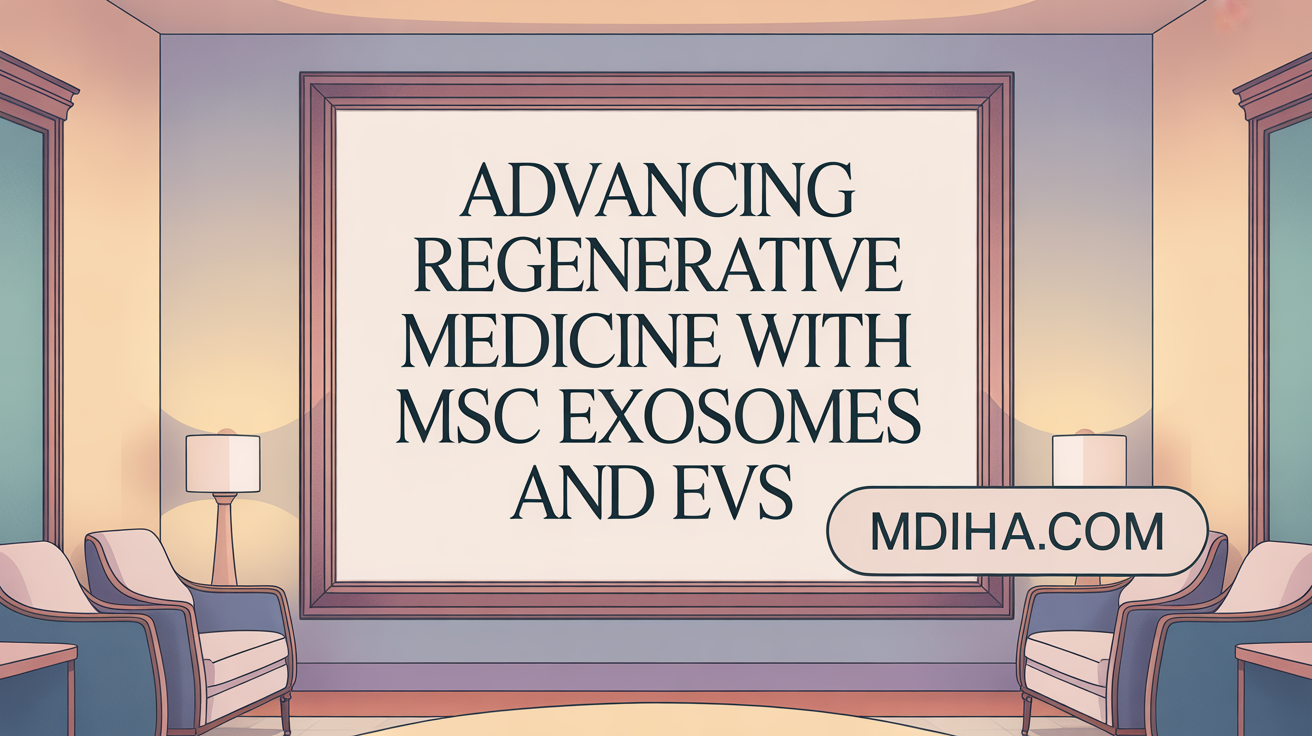
What are the benefits of MSC-derived exosomes and extracellular vesicles compared to traditional cell therapy?
MSC-derived exosomes and EVs are gaining attention as promising cell-free therapeutic options. Unlike live cells, these vesicles can carry proteins, mRNAs, and microRNAs that promote tissue repair, angiogenesis, and reduce cell death. This makes them effective in decreasing inflammation and enhancing healing processes.
Why are exosomes advantageous in terms of immune compatibility and storage?
Since exosomes are not living cells, they present a lower risk of immune rejection and can be stored more easily without the complex handling required for cell therapies. This stability allows for off-the-shelf availability, making treatment more accessible.
How do exosomes enable targeted delivery of therapeutic substances?
Exosomes naturally possess targeting abilities, as they carry specific surface proteins and molecules that facilitate binding to injured or inflamed tissues. This property enables precise delivery of their therapeutic cargo, maximizing efficacy and minimizing side effects.
What is the current state of research and clinical trials involving MSC exosomes?
Research is rapidly advancing, with numerous studies exploring their potential in treating myocardial infarction, lung injury, and neurodegenerative diseases. Several emerging clinical trials are evaluating safety, dosage, and effectiveness, indicating a growing interest in their translational application toward regenerative medicine.
| Aspect | Description | Additional Details |
|---|---|---|
| Advantages | Reduced immunogenicity, easier storage, cell-free | Overcome limitations of live cell therapies |
| Storage Benefits | Long shelf life, stability at room temperature | Facilitates mass distribution |
| Targeted Delivery | Natural homing abilities, surface markers | Enhance tissue-specific repair |
| Current Trials | Healing of myocardial infarction, lung, and neurological injuries | Ongoing safety and efficacy studies |
Challenges in Translating MSC Therapies from Bench to Bedside
The clinical application of mesenchymal stromal cells (MSCs) faces several obstacles that need addressing before they can be widely adopted. One major challenge is the standardization of cell isolation and expansion procedures. Variability in isolation techniques can lead to differences in cell population purity and characteristics, affecting therapeutic outcomes.
Ensuring the viability and potency of MSCs throughout manufacturing is crucial. Cells must be carefully cultured under optimal conditions to maintain their regenerative and immunomodulatory functions. Degradation or loss of function during expansion can reduce effectiveness.
Another difficulty stems from donor and tissue variability. MSCs derived from different sources, such as bone marrow, adipose tissue, or umbilical cord, exhibit diverse properties. Donor age, health, and tissue quality further influence cell behavior, posing challenges for consistent therapy.
Regulatory hurdles also impede progress. Manufacturing processes must adhere to strict standards to ensure safety, quality, and reproducibility. Variations in production protocols can lead to difficulties in obtaining regulatory approval. Overcoming these issues requires comprehensive quality control and standardized procedures.
In summary, addressing these challenges—ranging from technical standardization to regulatory compliance—is essential for translating MSC-based therapies from research to routine clinical practice, ensuring safe and effective treatments for patients.
Emerging Strategies to Overcome Limitations of MSC Therapies
To maximize the therapeutic potential of mesenchymal stromal cells (MSCs), researchers are exploring several innovative strategies. One promising approach is genetic modification, which aims to enhance MSC survival, homing ability, and regenerative functions. By inserting specific genes, MSCs can be made more resilient in the inflammatory microenvironment, increasing their longevity and effectiveness.
Another strategy involves developing advanced biomaterial scaffolds such as hydrogels, microgels, and patches. These materials improve MSC retention at the target site, providing a supportive niche that promotes cell survival and sustained tissue repair. Scaffold design can also control the release of MSC-derived factors, amplifying their paracrine effects.
Combination therapies are increasingly being considered, where MSCs are used alongside immune modulators to fine-tune the immune response. This synergy can enhance inflammation resolution and tissue regeneration, especially in conditions like inflammatory bowel disease or osteoarthritis.
Furthermore, priming MSCs through preconditioning techniques—such as exposing cells to hypoxia or inflammatory cytokines—can boost their secretion of trophic factors and immunomodulatory molecules. This preparation process results in more potent MSCs with improved migration, survival, and therapeutic output.
These innovative approaches are actively researched to address current MSC therapy limitations, aiming to refine delivery, enhance efficacy, and achieve better clinical outcomes.
Harnessing MSC Potential: Future Directions and Considerations
Mesenchymal stem cells are uniquely equipped to support injury healing and control inflammation through a sophisticated network of cellular interactions, secretory actions, and immunomodulatory mechanisms. Their capacity to home to damaged tissues, secrete regenerative trophic factors, and orchestrate immune responses positions them as a cornerstone in regenerative medicine. While clinical applications have shown encouraging safety and efficacy, challenges remain in standardizing therapies and enhancing therapeutic potency. Innovations such as priming, genetic engineering, and development of cell-free treatments like extracellular vesicles hold promise for overcoming current hurdles. As research advances, a deeper understanding of MSC biology and tailored strategies will be critical to fully realize their potential in treating injury and inflammation, offering improved outcomes for patients facing diverse degenerative and inflammatory conditions.
References
- Mechanism of action of mesenchymal stem cells (MSCs)
- The secretion profile of mesenchymal stem cells and potential ...
- MSCs and Inflammatory Cells Crosstalk in Regenerative Medicine
- Clinical application of mesenchymal stem cell in regenerative ...
- Roles of Mesenchymal Stem Cells in Tissue Regeneration and ...
- Mesenchymal Stem Cells: “Guardians of Inflammation”
- Mesenchymal stem cells for the management of inflammation in ...
